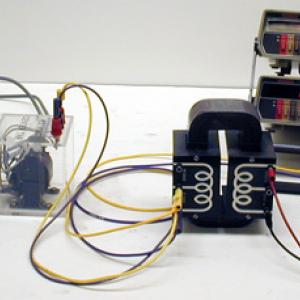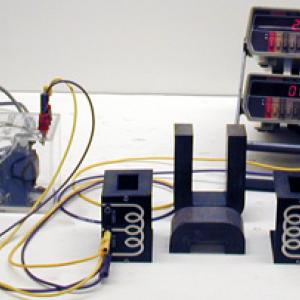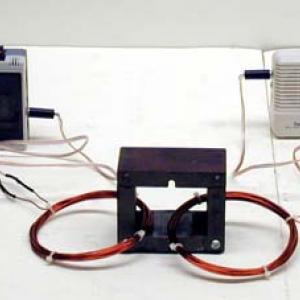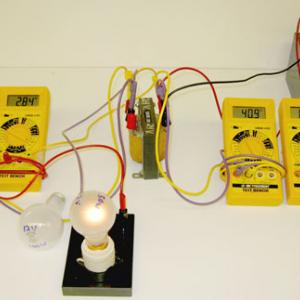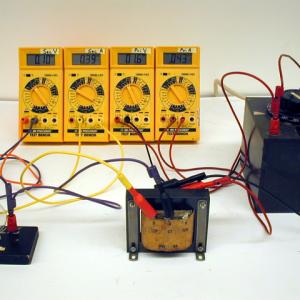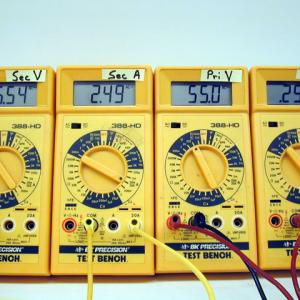College of Liberal Arts & Sciences
5K30.20 - Transformer Demo
Video Credit: Jonathan M. Sullivan-Wood
Setup is as shown. As the voltage is turned up with the Variac on the primary coil of the take-apart transformer, the secondary coil voltage will follow in the ratio that it is set for. For example if you are using 10,000 turns on the primary and 2000 on the secondary you will get a voltage ratio of 5 to 1. The step-down transformer is used to reduce the voltage so that the more delicate take-apart transformer is not damaged.
Plug one of the 15 turn coils into the tape player and play a tape. Plug the other 15 turn coil into the speaker/amplifier and turn this on. As you bring the two coils together the sound will intensify as the distance is decreased. An iron core will greatly increase this effect. Coil turn ratios may be explored using the 7 and 21 turn coils.
A cool spoof is to put the 30 turn coils on each side of a "volunteer's" head and listen to the "song stuck in their head". This shows that radio waves are in no way blocked or attenuated by the human body.
An extension of the first (above) mentioned setup is to monitor the voltage and the current for the primaries and secondaries. This establishes the relationship of total power in the primary as related to total power of the secondary. You will need to use the 24 volt transformer for this version. Also, using the 12 Volt, 50 or 100 watt bulbs will make the current high enough to get good readings.
CAUTION: Make sure you connect to the center tap on the secondary of this transformer so you don't burn out the 12 Volt bulbs.
- Leonid Minkin, "Comment on "Transformer Impedance Reflection Demonstration"", TPT, Vol. 61, #6, Sept. 2023, p. 426.
- William Layton, "Transformer Impedance Reflection Demonstration", TPT, Vol. 52, #7, Oct. 2014, p. 426.
- Eduardo E. Rodriguez, "Hands-on Experiments on Faraday's Law", TPT, Vol. 43, #4, Apr. 2005, p. 228.
- H. Richard Crane, "On Electric Shocks and Spinning Eggs", TPT, Vol. 27, #4, Apr. 1989, p. 300.
- Richard T. Weidner, "How Does a Transformer Really Work?", TPT, Vol. 20, #5, May 1982, p. 327.
- John Vanderkooy and June Lowe, "A Magnetic Circuit Demonstration", AJP, Vol. 63, #6, June 1995, p. 570.
- Rodney C. Cross, "Current Transformers", AJP, Vol. 54, #12, Dec. 1986, p. 1110.
- "B-435. Primary I vs. Secondary Load", DICK and RAE Physics Demo Notebook, 1993.
- G. D. Freier and F. J. Anderson, "Em-5", A Demonstration Handbook for Physics.
- A. D. Bulman, "A Variable Transformer", Model-Making for Physics, p. 146.
- Yaakov Kraftmakher, "3.10, Transformer", Experiments and Demonstrations in Physics, ISBN 981-256-602-3, p. 207.
- Ron Hipschman, "Transformer", Exploratorium Cookbook III, p. 154.1 - 154.3
- Joshua Buchman, Julie Nucci, and Marty Alderman, "Power to the People!", CNS Institute for Physics Teachers, July 2009.
- Marsha Hobbs, "Radio Transformer", PIRA News, Vol. 6, #3, Feb. 1993, p. 3.
- "The Transformer", Selective Experiments in Physics, CENCO, 1962.
- Curt Suplee, "Living on The Grid", Everyday Science Explained, National Geographic, p. 98.
- Grant Mellor, "An Incredible Shock", Flying Tinsel, 1993, p. 117 - 121.
- Rudolf F. Graf, "Let Us Make a Transformer", Safe and Simple Electrical Experiments, p. 99.
Disclaimer: These demonstrations are provided only for illustrative use by persons affiliated with The University of Iowa and only under the direction of a trained instructor or physicist. The University of Iowa is not responsible for demonstrations performed by those using their own equipment or who choose to use this reference material for their own purpose. The demonstrations included here are within the public domain and can be found in materials contained in libraries, bookstores, and through electronic sources. Performing all or any portion of any of these demonstrations, with or without revisions not depicted here entails inherent risks. These risks include, without limitation, bodily injury (and possibly death), including risks to health that may be temporary or permanent and that may exacerbate a pre-existing medical condition; and property loss or damage. Anyone performing any part of these demonstrations, even with revisions, knowingly and voluntarily assumes all risks associated with them.
